Nürburgring
50.3355727686116.9475838541667Coordinates: 50° 20′ 8.1″ N, 6° 56′ 51.3″ E
The Nürburgring is a motorsport race track named after Nürburg Castle in the area of the municipality of Adenau (Ahrweiler district, Rhineland-Palatinate) in the Eifel region and was inaugurated on 18 June 1927. The "mountain, race and test track", which was originally about 28 kilometres long, was in operation in its original form until 1982. The Nürburgring is the longest permanent race track in the world.
In 1984, the "most modern and safest Grand Prix circuit in the world" at the time was opened in the area of the start-finish loop and the south loop. The then 4.5-kilometre GP circuit was directly connected to the 20.8-kilometre Nordschleife. Both sections can be combined to form a 26-kilometre long overall circuit, which is, however, only used for races in a modified form: For NLS/VLN races without the Müllenbachschleife (24.433 kilometres), for the 24-hour race without the Mercedes Arena (25.378 kilometres). Furthermore, the Grand Prix circuit can be divided into the sprint circuit (so-called short version) and the Müllenbachschleife (southern part of the circuit).
In the course of the Nürburgring 2009 project, a large leisure centre with roller coaster, shopping centre, the Eifel village "Grüne Hölle" with Eifel Stadl discotheque, hotel and holiday village were built in the immediate vicinity of the race track from 2007 onwards in a construction period of around two years.
After Nürburgring GmbH filed for insolvency in the summer of 2012, the circuit was sold to the automotive parts supplier Capricorn on January 1, 2015. Since the end of October 2014, Russian billionaire Viktor Charitonin had held two-thirds of the shares in the Nürburgring through NR Holding and had thus taken over the Capricorn shares. Another third continued to belong to Getspeed. In 2016, the ownership structure changed again. The minority shareholder GetSpeed gave up all but 1% of its shares to NR Holding, which accordingly now holds 99% of the shares in the racetrack.
The Nürburgring is operated by Nürburgring 1927 GmbH & Co KG, a 100% subsidiary of the Nürburgring Besitzgesellschaft. According to its own information, the Nürburgring 1927 GmbH & Co KG is in the black. The range of events still includes motor sport events such as the ADAC TOTAL 24h Race, but also music festivals such as Rock am Ring and sporting events. In addition, the circuit is used on weekdays for test drives and other driving events. During the marketable period from mid-March to mid-November, both sections - the Grand Prix circuit and the Nordschleife - are at full capacity every day, according to the Nürburgring.
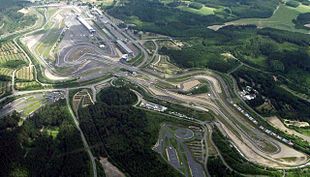
Nürburgring, Grand Prix circuit (top left a part of the Nordschleife)
History
1904 to 1925: Idea and planning
In 1904, the Belgian Automobile Club organized a circuit race in the Ardennes, in Italy the Coppa Florio was held at the same time and in the USA the Vanderbilt Cup was held. All these races were very busy and enjoyed a high level of popularity, so much so that on 17 June 1904 the Gordon Bennett Race was held in Bad Homburg vor der Höhe. The race, in which drivers from Germany, Switzerland, France, England, Italy and the USA took part, led to a fundamental realisation in Germany: motor racing is popular and also brings great financial success, but for aspects of driver and spectator safety and for logistical reasons it can no longer be held on German country roads. It therefore quickly became clear that a track was needed in Germany that was independent of road traffic and on which German car manufacturers could also test their models.
Kaiser Wilhelm II then had plans drawn up for a race track that was suitable for this requirement. The Eifel quickly crystallised out as the most suitable location for such a track: it had a low population density, high plateaus and valleys, as well as some large flat areas. The extreme uphill and downhill gradients were ideal conditions for a race track with large differences in altitude. After 1907, however, motor racing quickly lost popularity again and planning work on the project was discontinued.
After the First World War, the automobile experienced a considerable boom in Germany; the number of automobile and motorcycle factories rose rapidly. The increasing motorization in Germany provided for a renaissance of motor sports. The Allgemeine Deutsche Automobil-Club (ADAC) and the Automobilclub von Deutschland (AvD) promoted motor sports, so that more and more motor sports events took place in Germany and more and more people devoted themselves to motor sports. The desire for a suitable race track arose again. So the plans of 1907 were taken up again.
Once again, the Eifel was chosen as the location for the new race track. In addition to the geographical advantages mentioned above, another point was taken into account when selecting the location: Even after the First World War, the Eifel was a very structurally weak region with a low level of industrialisation (the local tobacco and cloth industries hardly played a role any more), and agriculture could only be practised to a limited extent in the Eifel due to the stony soils. Thus, the planners came to the conclusion that the construction of the race track in the Eifel could bring about an improvement in the economic and infrastructure.
Before the decision to build was made, the ADAC-Rheinland held the 1st Eifel Race. Races in four touring car and five motorcycle categories were held on a 33 km circuit near Nideggen on 15 July 1922. A total of 134 drivers took part. This first Eifel race was attended by about 40,000 spectators, which encouraged the decision to build a race course. The ADAC Gau Rheinland took the planning in hand.
In the middle of 1923, the ADAC began negotiations with the city of Münstereifel. There, the city forest was offered as a site. The realisation failed, however, as the loans required to finance the route were not approved.
In the course of the Second Eifel Race, which took place from July 17 to 19, 1924, a decisive conversation took place between Hans Weidenbrück, leaseholder of the Nürburg municipal hunting ground, Xaver Weber, member of the district council of Adenau, and Hans Pauly, head of the municipality of Nürburg. Discussing the dangers to drivers and spectators during a race, Weidenbrück recalled the plans to build a racecourse, which had begun in 1907 but were not completed. He collected the advantages of the area between Adenau and Mayen, contrasted them with the current venue of the Eifel race around Nideggen and was then commissioned to present his plan to the ADAC in Cologne. After a first discussion between the ADAC and Weidenbrück, the latter founded his own automobile club, whose sole purpose was to put the construction of the race track in the west of Germany into practice. The chairman of this club was Otto Creutz, the newly elected district administrator of the Adenau district.
1925 to 1927: The construction phase
Not a month passed until the ADAC again thought about the construction of a race track, but this time very intensively. After this meeting, Creutz now began to develop the concept for the construction of this race track. According to him, the self-contained "endless" race track should also lead around the Nürburg. One important detail was taken into account by the ADAC from the very beginning and was integrated into the considerations: The race track was not to have any connection to the public road network, nevertheless, according to Creutz' wishes, a certain "country road character" was to be created. However, it was not lost sight of the fact that the new race track was also to be a test track for vehicle trials. Therefore, as many characteristics of European country roads as possible were to be simulated, for example, long stretches of road for testing high speeds as well as winding gradients (a total of more than 170 curves were planned) with gradients of up to 17 percent.
On April 15, 1925, Creutz - supported by the Center - met with representatives of the Prussian Ministry of Welfare and the Reich Ministry of Transport in Berlin. He explained the importance of building the racetrack in the "poorest district in the state of Prussia" and described it as an "emergency measure within the framework of productive welfare for the unemployed."
After that, the construction of the line was finally decided. The costs were calculated at 2.5 million Reichsmark. At the end of April 1925, surveying work began, after minor work had already been carried out on the planned route. On May 20, 1925, Johannes Fuchs confirmed the construction site, and on June 13 of the same year, the engineering office Gustav Eichler, Ravensburg, was commissioned to take over the construction management. Three days later, the official press releases were sent to the German sports press, which published the site plan and the construction plans as early as June 24. The engineering office prepared a cost estimate of 4 million Reichsmark. This did not take into account the expenses for the necessary structural engineering, since this work was not part of the emergency work and accordingly could not be financed with tax money.
The plans for the race track were as follows: The total length of the track was to be 28.3 kilometres. Various track layouts were designed for this purpose. The longest part of the track was the Nordschleife with a length of 22.8 kilometers. In addition, the routes of the south loop with a length of 7.7 kilometres and the start-finish loop with a length of 2.2 kilometres were also determined. The longest straight was to be 2.6 kilometres long and extend to the Tiergarten. The average width of the track was set at eight metres. The track was to have gradients of eleven percent and inclines of up to 17 percent; in addition, a steep section with a gradient of up to 27 percent was designed. In addition, a two-storey start and finish building was planned, as well as a pit lane with 50 pits and a modern, for the time, spacious racing paddock (today's historic paddock) with 70 lockable garages for the teams. These figures are still partly up to date today.
Work on the new racetrack began on July 1, 1925, although the necessary building permit was not issued until early August. On August 13, the Prussian Ministry of Welfare formally declared the construction to be major emergency work.
The district of Adenau could not provide the required number of workers. Therefore, workers were brought to Adenau from the administrative districts of Koblenz and Cologne. Barracks were erected to house these workers.
On September 27, the official laying of the foundation stone took place, performed by Johannes Fuchs. During this official start of construction, the race track was given the name Nürburgring, as proposed by the district president Francis Kruse. The name was given to the ruins of Nürburg Castle and the village of the same name, which, like Quiddelbach, Herschbroich and Breidscheid, lie within what is now the 20.8-kilometre-long Nordschleife.
At the beginning of 1926, more than 2,100 construction workers were employed, and at peak times as many as 2,500 people worked on the completion. In total, they performed about 784,500 daily works, moved 152,097 cubic metres of earth, 184,693 cubic metres of rock and processed 11,119 cubic metres of concrete.
In April 1926, even before construction of the circuit was completed, the first issue of a magazine called Nürburgring appeared. It was printed with a circulation of 12,000 copies.
The first drives on completed sections of the Nürburgring were carried out by the ADAC Adenau on August 28. At the same time, the construction cost planning had to be revised upwards from the previous 5 million Reichsmark to about 8.1 million Reichsmark. Just two years after the start of construction, the Nürburgring could be opened.
1927 until 1970
The first managing director of the Nürburgring from 1927 was Alex Döhmer from Cologne. The premiere was on Saturday, June 18, 1927 with the Eifel Race for motorcycles over the entire 28 km course, and one day later with an automobile race won by Rudolf Caracciola. Caracciola found the first mountain, race and test track with its many curves, gradients and jumping hills to be bearishly difficult.
From the beginning, the track could also be used by anyone with a road vehicle in the evenings or on race-free weekends for a fee.
The classic 22.8 km Nordschleife version of the circuit, which was used until 1976, is still considered one of the most difficult Grand Prix circuits in the world. Jackie Stewart described the mountain-and-valley track surrounded by woods and hedges as a green hell. The difference in altitude between the sections near Breidscheid on the one hand and the Hohe Acht or near Nürburg on the other is almost 300 metres.
There was also the lesser-known 7.7-kilometre southern loop, which ran through the Müllenbach district. The option of combining the two to form a course of around 28 kilometres was rarely used from 1931 onwards, such as for the 84-hour Marathon de la Route in the 1960s. Sprint races were also held on the course around the start-finish area (the start-and-finish loop or concrete loop), which was only 2.2 km long and was also used for warming up or starting the stopwatch before a training lap over the full distance.
As early as the 1928 German Grand Prix, Čeněk Junek, a well-known driver, had a fatal accident, followed by others in the 1930s. The Argentinean Onofre Marimón was the first Formula 1 driver to have a fatal accident at the Nürburgring in 1954. At the 1958 German Grand Prix, the Briton Peter Collins died. A few days after the 1966 Grand Prix, driver John Taylor died from burn injuries sustained in his accident. Gerhard Mitter took part in Formula 1 practice in 1969 in a BMW Formula 2 and had a fatal accident at the Schwedenkreuz. The narrow track with hedges in many places directly at the edge of the carriageway had come under increasing criticism since the end of the 1960s in view of the ever faster vehicles.
In 1970, the Formula 1 drivers briefly imposed a boycott, whereupon the German Grand Prix was temporarily held at the Hockenheimring. This high-speed circuit had been rebuilt after Jim Clark's fatal accident in 1968, with protective barriers in particular being used, which were still missing at the Nürburgring, which was three times as long.
1970 until 1983
After reconstruction work on the Nordschleife in 1970/71, Formula 1 returned to the Eifel for two three-year periods, although further reconstruction measures were required in each case. Due to the slope, however, it was not possible to create the required wide run-off zones in many places, as this would have required enormous earth movements. In addition, the ambulances always had to cover kilometre-long distances in the event of accidents. The shorter south loop was not rebuilt and from the mid-1970s was no longer used for circuit races. Instead, several hillclimb races were held starting in Müllenbach.
It was already clear that Formula 1 would hold its last race at the Nürburgring on August 1, 1976, due to these safety deficiencies. This race was then additionally overshadowed by Niki Lauda's serious fire accident, which, however, was not the cause for the final relocation of the Formula 1 race to Hockenheim, as is still often and gladly rumored.
The Motorcycle World Championship last held a Grand Prix on the Nordschleife in 1980. Other racing series such as the Formula 2 European Championship, the German Racing Championship (DRM), the ADAC 1000 km Nürburgring, the Sports Car World Championship, etc. were still able to hold their competitions - despite major misgivings - until 1983, but during the ongoing conversion work on a circuit shortened to 20.8 kilometres with a temporary pit area.
The new Grand Prix circuit
After Formula 1 only raced at Hockenheim from 1977 onwards and other international series also threatened to leave, the possibilities of renovating the Nürburgring were discussed. In the end, the choice fell on a modern racetrack that was only about 4.5 kilometres long for cost reasons and only had the start-finish straight in common with the old racetrack. The original south loop was abandoned and rededicated to public traffic or used as access roads to parking lots. The shortened Nordschleife, including the small pit area from 1983, still exists and can be used largely independently of operations on the neighbouring Grand Prix circuit, for example by the RCN and GLP.
In 1984, the Grand Prix circuit with its wide run-off zones was inaugurated with an event broadcast live on German television. The first race held on the new track was a show race with 20 identical Mercedes-Benz 190 E 2.3-16 touring cars, in which many top-class racing drivers of the time competed, including nine former Formula 1 world champions: Jack Brabham (1959, 1960, 1966), Phil Hill (1961), Denis Hulme (1967), James Hunt (1976), Alan Jones (1980), Niki Lauda (1975, 1977 - the 1984 title was still in the future at that time), Keke Rosberg (1982), Jody Scheckter (1979) and John Surtees (1964). Other names familiar from Formula 1 were Elio de Angelis, Jacques Laffite, Stirling Moss, Alain Prost, Carlos Reutemann and John Watson. The winner, however, was the then little-known Brazilian Formula 1 rookie Ayrton Senna, who had taken over the car originally intended for his compatriot Emerson Fittipaldi and who was the only one who managed not to be overtaken by Niki Lauda, who had started from the last row without training.
In winter 1994 and in May 1997 the Veedol chicane (later NGK chicane and now Veedol chicane again) was rebuilt. This narrower track layout significantly reduces the speed of the vehicles. In addition, a separate track layout for motorcycle racing was set up here in 1997, which is also used for the 24-hour race.
In 2002, the track was extended to about 5.1 kilometres with the construction of the Mercedes Arena. In addition, the pit area was completely rebuilt in 2000, with a total of 33 garages that are so high that they are also suitable for trucks.
The Formula One World Championship held two races at the new Nürburgring in 1984 and 1985, but from 1986 the German Grand Prix was again held at the Hockenheimring. In turn, the Motorcycle World Championship moved from Hockenheim to the Eifel for a few rounds in the 1990s, but has been held at the Sachsenring since 1998.
From 1995 to 2006, a second Formula One race was held annually in Germany, designated as the European Grand Prix (in 1997 and 1998 as the Luxembourg Grand Prix, as the European Grand Prix was held in Jerez [Spain] as the season-ending event in 1997 and not at all in 1998). After the 2002 rebuild, the distance was 60 laps or 308.863 kilometres in each case.
In 2006, it became known that Formula One promoter Bernie Ecclestone wanted to allow only one Grand Prix round per year in Germany from 2007 onwards, alternating annually between the Hockenheim and Nürburgring circuits, despite existing contracts with both circuits. The 2007 German Grand Prix was held at the Nürburgring as the European Grand Prix, there was no German Grand Prix that year. Since the naming rights for this lie with the Automobile Club of Germany, this Grand Prix was not held again until 2008 at the Hockenheimring.
In January 2007, the Rhineland-Palatinate Court of Auditors accused the racetrack operators of mismanagement. The Formula One events in 2004 and 2005 had each caused losses of around nine million euros. The Formula One Administration Ltd. controlled by Bernie Ecclestone. (FOA) had been paid an annual entry fee of around 16 million euros. The total costs per Grand Prix would increase by about ten percent annually.
On March 25, 2007, Nürburgring GmbH Managing Director Walter Kafitz announced that the "Shell" curve between Dunlop-Kehre and Kumho-Kurve (No. 11) was to be renamed Michael-Schumacher-S. Schumacher personally came to the track for the baptism of the curve on 22 July 2007 as part of the European Grand Prix.
A biomass heating plant was commissioned in 2010. The sponsor is RWE, the location is close to the leisure and business centre.
But various motorcycle, truck, classic car and DTM races, as well as some one-make cups, are also at home on the GP circuit of the Nürburgring. Likewise, all single-seater series as well as GT race cars and sports cars only race on this "safe" variant. Nevertheless, some drivers have suffered serious or even fatal injuries there over the years, but this could hardly be blamed on the condition of the circuit. Since the 2008 season, the German round of the Superbike World Championship has been held at the Nürburgring.
Routings
· Routing 1927-1967
· 
Total distance from 1927 to 1967
· 
Start and finish loop/concrete loop in detail with start and finish straight
· 
Nordschleife in detail with south bend
· 
South loop in detail
· Routing 1967-1983
· 
Entire line 1967-1972, first reconstructions, e.g. Hohenrain
· 
Complete line 1973-1982, 2nd reconstruction wave, among other things connection of the south loop
· 
Nordschleife 1967-1982, with start-and-finish loop/concrete loop
· 
Total track 1983, during the construction of the Grand Prix track
· Routing since 1984
· 
Total track with new Grand Prix track 1984-1994
· 
Total track with Formula 1 chicane 1995-2001
· 
current total distance since 2002 with Mercedes Arena
· 
new Grand Prix track 1984 still without Veedol chicane
· 
Grand Prix circuit, with new Formula 1 chicane as of 1997
· Route variants of the current route
· 
the 24-hour race variant without Mercedes Arena since 2005
· 
the Nordschleife in detail since 2002
· 
the Grand Prix circuit in detail, with Mercedes Arena since 2002
· 
the sprint track with short connection since 2002
· 
the Müllenbachschleife in detail since 2002
· 
1991-1997 used rallycross track
· 
the supermoto-cross track from 2009

enlarge and show information about the picture
![]()
Start and finish straight and pit lane of the Nürburgring. (The dead-straight section of the track appears bent in the picture for photo-technical reasons).
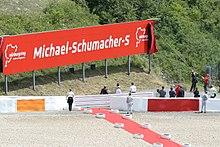
Unveiling of the "Michael Schumacher S" by Michael Schumacher and Bernie Ecclestone
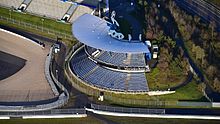
Mercedes Grandstand, aerial view (2016)

Bernd Rosemeyer in 1937 on Auto Union Type C at the Nürburgring
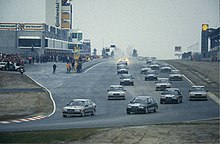
Race for the opening of the Grand Prix circuit on 12 May 1984

Bugatti T37A from the opening race of the Nürburgring 1927
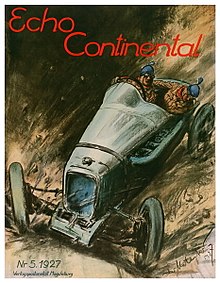
The winners Rudolf Caracciola with co-driver in the Mercedes Type S at the opening race on 19 June 1927; Cover by Theo Matejko for the magazine Echo Continental
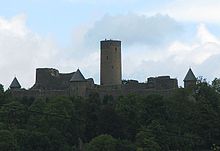
The Nürburg as namesake for the car race track
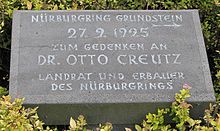
Memorial stone Laying of the foundation stone on 27 September 1925 for District Administrator Otto Creutz
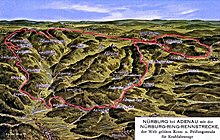
A bird's eye view of the Nürburgring in 1927, map by Eugen Felle
Other races
In conjunction with the 20.8-kilometre Nordschleife, up to 25.9-kilometre variants can be combined on which touring cars contest VLN endurance races lasting several hours and, in addition, the 24-hour race. Here, up to 190 cars of various degrees of modification, engine capacity and drive classes are in the race at the same time, with around 700 drivers (amateurs and professionals) taking turns at the steering wheels.
One of the most important events of the European classic car scene with up to 30,000 visitors takes place every year at the beginning of August, the AvD Oldtimer Grand Prix. On the Grand Prix circuit, racing cars from different eras are moved to racing and regularity races. At the same time, many classic car clubs meet in the parking lots around the Nürburgring.
In the evenings and on Sundays, anyone can drive their road car on the Nordschleife for a fee. The entire circuit is also used for sports driver training courses, where aspiring racing drivers and those interested in racing can learn the ideal line on the Ring, for test drives by the automotive industry and the press, and for much-discussed record laps.
In the area of the Müllenbach loop in the southern part of the GP circuit, there are additional gravel passages in addition to the normal asphalt course, which meant that rallycross races could also be organised here by the ADAC (Regional Club North Rhine) from 1991 up to and including 1997. The FIA International Cup races (a European rallycross cup for national teams) in 1992 and 1993 can be regarded as prestigious international competitions in this discipline. In addition, the second Race of Champions in the history of motor sport took place in this "rallycross stadium Müllenbachschleife" in 1989. This mixed surface track has been reactivated for December 12 and 13, 2020, so that a round of the World Rallycross Championship can also be held here in the future. However, due to the Corona situation in Germany, the race was cancelled at short notice and the first German World Rallycross Championship round was scheduled for 31 July and 1 August 2021. However, in future the track will be driven anticlockwise, instead of clockwise as in the 1990s, and the gravel loop at the far end of the area will be used for the so-called Joker Lap.
Each year, the special stages of the Cologne-Ahrweiler Rally lead over the remains of the south loop and, in the opposite direction, over the north loop.
There were also hill climbs starting in Müllenbach, the lowest point of the south loop. Driving was against the usual direction up to the start and finish. Since the return route then continued in a circle back to Müllenbach, uninterrupted operation was possible. Such hillclimb races could be completed within one day with all training and scoring runs.
Until 2002, a 1,300-metre-long kart track existed next to the paddock. The Mercedes Arena was built on this site and areas were asphalted for an extended paddock.
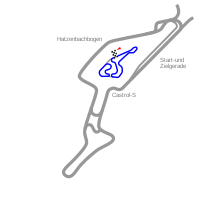
Nürburgring kart track from 1984 to 2001
Search within the encyclopedia